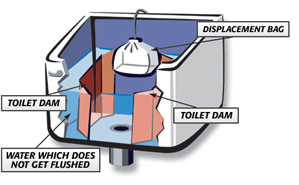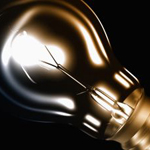Water
Leaky faucets are one of the biggest wastes of water in the household! Always be sure to fix them as soon as possible. "Low-flow" showerheads are beneficial as they reduce water consumption by 50% or more with every use. Bathroom-ware made before 1993 should be used with discretion as these products were not made with concern for water-use efficiency. If your toilet is more than ten years old, it's probably a water-waster, using about 18 liters or more of water per flush. There are many products that you can install in the tank of an existing toilet to reduce the amount of water used in a flush cycle. These devices fall into three generic categories:
- Water retention (toilet dams - picture below)
- Water displacement (plastic bag or bottle - picture below)
- Alternative flushing (early closure or dual-flush)

See your local plumbing supply or hardware store to find out which type will work best for your toilet. Toilet dams are popular, because they are easy to install. They need to be checked periodically to ensure they have not slipped out of place. You'll save about 5 liters per flush using a set of two. Always remember that although the picture above shows both a plastic bag AND a toilet dam in the same tank, THIS IS NOT RECOMMENDED, it is used for demonstration purposes only.
If your toilet was manufactured after 1985, it could be a water-conserving type which used about 13 liters per flush. These types usually have an insulated foam liner in the tank. If you have a toilet tank like this, try one toilet dam at one end of the tank first. Installing both dams in a set may cut water use too much and prevent the flush cycle from clearing the bowl - leading to double flushing.
Always Remember: Do NOT put rocks or bricks in your tank because they can break down over time and cause damage.
For more facts on how to save water, visit the Nature Conservancy's Water Conservation page.
Energy
It's easy to miss opportunities to go green in your own house. Small things like painting walls in lighter colors instead of dark can help to maintain light, reducing the amount of money and energy you spend on lighting. It's important to invest in good window panes and insulation as almost 15% of the energy you use for heating your home can dissipate through improperly sealed windows. Switching to more green friendly light bulbs is a smart choice – a 60-watt incandescent bulb lasts about 750 hours, while a fluorescent bulb with 1/3 the wattage will generate the same amount of light and burn for 7,500 to 10,000 hours (over ten times as long as regular lights). Always remember to turn off all electronics like radios, televisions, and lights when you leave a room. For more information on energy savings in the home visit Hydro Quebec's Energy Wise website.


